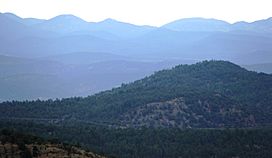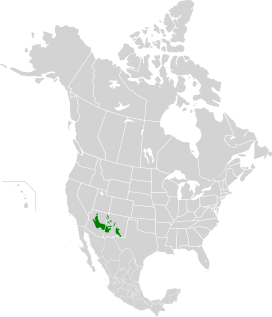Arizona Mountains forests facts for kids
Quick facts for kids Arizona Mountains forests |
|
|---|---|

|
|
 |
|
| Ecology | |
| Realm | Nearctic |
| Biome | Temperate coniferous forests |
| Borders | Colorado Plateau shrublands, Chihuahuan Desert and Sonoran Desert |
| Bird species | 208 |
| Mammal species | 123 |
| Geography | |
| Area | 109,100 km2 (42,100 sq mi) |
| Country | United States |
| States | Arizona, New Mexico and Texas |
| Rivers | Gila River |
| Conservation | |
| Habitat loss | 0.307% |
| Protected | 73.78% |
The Arizona Mountains forests are a special type of forest found in the southwestern United States. This area is known as an ecoregion, which means it's a large natural area with similar plants and animals. It has many different kinds of woodlands and lots of wildlife.
Contents
What is the Arizona Mountains Forest Like?
This ecoregion has steep mountains and high, rocky plateaus. It stretches from the Kaibab Plateau in northern Arizona all the way south to the Mogollon Plateau. It also goes east into southwestern New Mexico.
How High Are These Mountains?
The land here is usually between 1,370 and 3,000 meters (about 4,500 to 9,800 feet) high. Some mountain peaks are even taller! An important part of this area is the Gila Wilderness in New Mexico.
What Plants Grow Here?
The trees in these forests are a mix of different types. You'll find some trees that are common in the Rocky Mountains further north. These include spruce and fir trees, and also quaking aspen (Populus tremuloides).
Unique Trees of the Southwest
You'll also see trees that are more typical of Mexico. These include the Chihuahua pine (Pinus leiophylla), Apache pine (Pinus engelmannii), and the Arizona pine. The Arizona pine is found in places like the Gila Wilderness.
Lower Elevation Woodlands
At lower elevations, the forests change. Here, you'll find a mix of pinyon pine, juniper, and oak trees. Rivers and their banks are also very important habitats. They provide homes for special plants and animals, including different kinds of fish.
What Animals Live Here?
The Arizona Mountains forests are home to many interesting animals. You might spot the tiny northern saw-whet owl. Many birds and reptiles that are common in Mexico also live here. One example is the shy Montezuma quail.
Cave Dwellers
The caves in the Guadalupe Mountains are a special home for certain creatures. These include different kinds of beetles, centipedes, and other invertebrates (animals without backbones).
Protecting the Arizona Mountains Forests
This ecoregion is quite stable, meaning it hasn't changed too much over time. About 25% of its original natural habitat is still left. However, it faces some challenges.
What Are the Threats?
- Logging: Cutting down trees can remove homes for animals.
- Overgrazing: Too many animals eating plants can harm the land.
- Pollution: Dirtying the rivers and land can hurt plants and animals.
- River Changes: Less water in rivers threatens specific plants and animals.
Animals and Plants at Risk
Some plants and animals are especially vulnerable. These include the Fremont cottonwood (Populus fremontii) and Goodding's willow (Salix gooddingii). The Gila trout (Oncorhynchus gilae) is a threatened fish. The southwestern willow flycatcher (Empidonax traillii extimus) is an endangered bird. Logging also affects the Mexican spotted owl (Strix occidentalis lucida) and the northern goshawk (Accipiter gentalis).
Protected Areas
Luckily, many large parts of this ecoregion are protected. These areas help keep the forests safe. Some important protected places include:
- The Aldo Leopold Wilderness, Gila Wilderness, and Blue Range Wilderness in New Mexico.
- El Malpais National Monument and Conservation Area in New Mexico.
- The Kaibab National Forest, Blue Range Primitive Area, and Grand Canyon National Park in Arizona.
- The Mazatzal Mountains (including Four Peaks), Superstition Mountains, Sycamore Canyon, Red Rock-Secret Mountain Wilderness, Hellsgate Wilderness, and Pinal Mountains in the Tonto National Forest in Arizona.
- The Galiuro Mountains in Arizona.
- The Chuska Mountains on Navajo lands.
- The Guadalupe Mountains, which include Carlsbad Caverns in New Mexico and Texas.
Many of these protected areas are connected. This helps wildlife move freely and keeps the habitats healthy.

